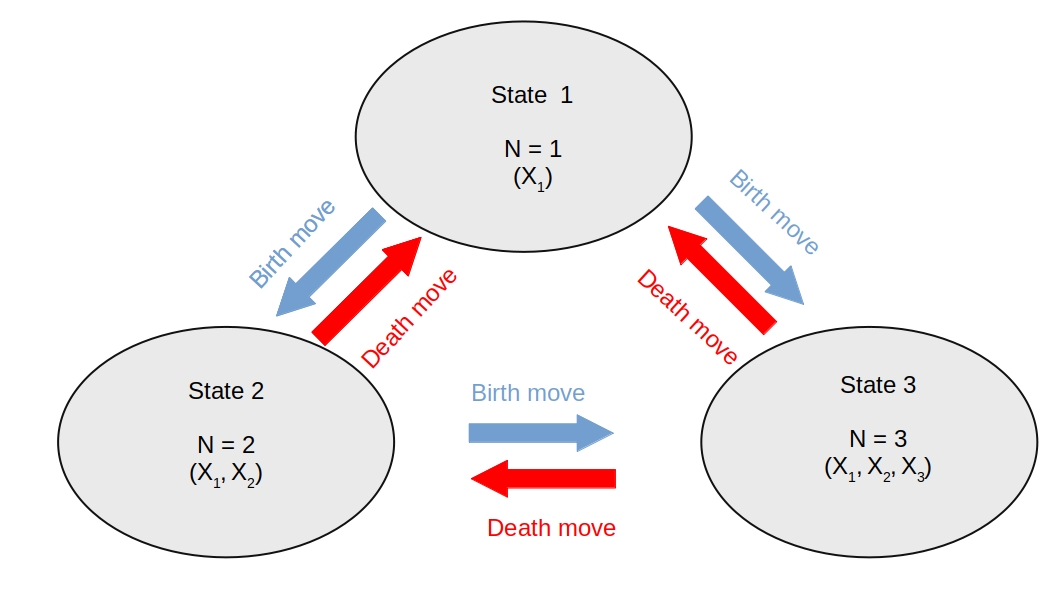Transdimensional MCMC (DRAFT)#
Introduction#
Markov chain Monte Carlo (McMC) methods have been used extensively for Bayesian computation to solve the problems where the joint distribution of all variables has a density with a fixed number of dimensions. However, there are a variety of challenging statistical problems where the dimension of the object of inference is variant e.g. biological systems, mapping, and subsurface imaging. In these cases, the general McMC methods have therefore not been available for application to Bayesian model selections and determination as the dimensionality of the parameter vector (model space) is typically not fixed. For example, in subsurface imaging problems, as we do not exactly know the number of subsurface layers, we used to fix the number of layers and compute the model parameters (e.g. velocity, density) for each layer. Rather than fixing the number of layers based on the user’s assumption, the transdimensional approach is the name given to the case where this assumption is relaxed, and view the number of layers that is related to model parameters as unknown.
Transdimensional Markov chains are an extension of McMC sampling algorithms that allow transitions between models with different numbers of dimension as shown in Fig. 30 to achieve a broad subspace of the inter-related sampling framework. The posterior probability distribution (PDFs) produced by McMC hence becomes a transdimensional function. To sample arbitrary dimension PDFs, the reversible-jump Markov chain Monte Carlo (rj-McMC) sampler given by Green, a generalization of the well knownMetropolis-Hasting algorithm, is the most common McMC tool for exploring variable dimension statistical models.

Fig. 30 A illustration shows how Rj-McMC jumps across three independent state spaces. The number of variables (\(N\)) are different between states. \(X_1\), \(X_2\), \(X_3\) represent each variable.#
Reversible-jump Markov chain Monte Carlo (Rj-McMC)#
Rj-McMC is capable of jumping between subspaces of differing dimensionality and avoids the need for computing marginal data densities by treating the number of dimensions as an unknown parameter [Green, 1995, Sambridge et al., 2006]. This considerably extends the use of Metropolis-Hastings rules to cases where the proposal distribution not only moves a point within the current model (or state) space, but also between state spaces, of different dimensions or types.
Rj-McMC method proceeds by using reversible jump moves, to construct a Markov chain where typically each is a perturbation of the last. The resulting Markov chain simulations jump between such distinct models and form samples from the joint distribution. The algorithm is designed to be reversible such that irreducibility and aperiodicity of the Markov chain are maintained and it surely converges to the correct target measure.
The starting point of the chain is selected randomly and the perturbations are governed by a proposal probability distribution which only depends on the current state of the model. To jump between different dimensions, new types of proposals come in reversible pairs which are birth (increase dimension) and death move (decrease dimension). For within-model proposals where model dimension does not change from current to proposal one, the principles are identical to the fixed-dimensional McMC. For across-model proposals where model dimension changes from current to proposal one, usually, the acceptance probabilities are much lower than within-model moves. Thus, it is necessary to design appropriate reversible jumping rules (e.g. reversible proposal choice and acceptance mechanism) to produce computationally efficient and theoretically effective methods [Lopes, 2006].
Application#
References#
- Gre95
Peter J Green. Reversible jump markov chain monte carlo computation and bayesian model determination. Biometrika, 82(4):711–732, 1995.
- Lop06
Hedibert Freitas Lopes. A note on reversible jump markov chain monte carlo. Graduate School of Business, The University of Chicago, 2006.
- SGJR06
Malcolm Sambridge, K Gallagher, Andrew Jackson, and Peter Rickwood. Trans-dimensional inverse problems, model comparison and the evidence. Geophysical Journal International, 167(2):528–542, 2006.
Contributors#
Jonas bauer, Frederik Tilmann
